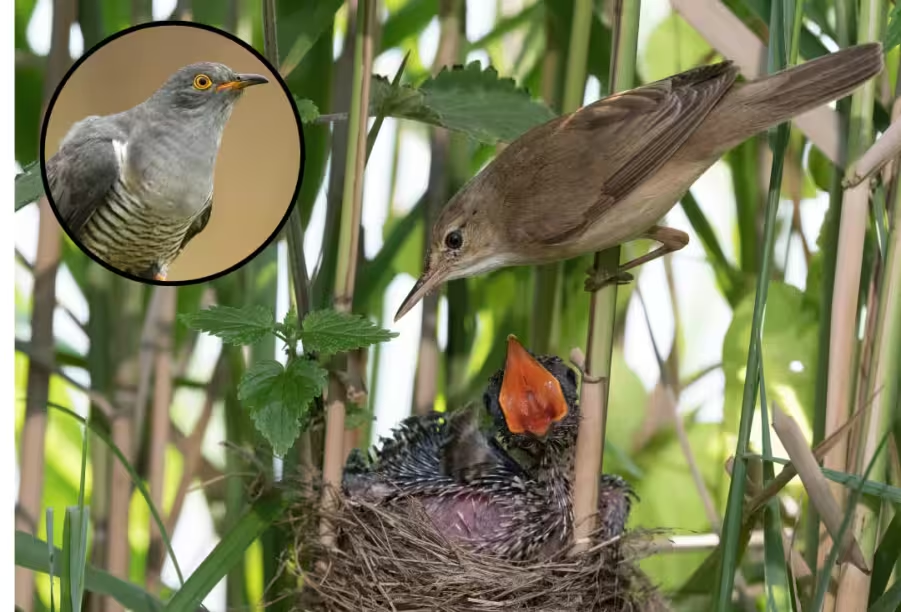All living things need to accomplish two things to keep the natural world running: (1) they need to survive, and (2) they need to reproduce. There are lots of amazing and bizarre examples of adaptations to solve the first problem. For example, camouflage and aposematic coloration help some animals stay hidden or advertise powerful defenses. However, wildlife also address the second problem in lots of weird and fascinating ways. In this Deep Stuff post, let’s dive into one especially cool strategy for reproduction: nest parasitism.
Read more: what is a life cycle?
Nest parasitism and brood parasitism: how it works

The cuckoo’s story may be a familiar one: it lays its eggs in another birds’ nest, and then leaves the scene. The egg is lovingly brooded and cared for by its unwitting foster parents, who spend tons of effort raising and feeding a baby that isn’t theirs. This is a classical case of what scientists and naturalists call nest parasitism or alternatively brood parasitism. Specifically, it refers to cases where an animal is able to deceive another animal into caring for its young. The advantage is obvious: the cuckoo in this example gets off easy and can go lay more eggs. Meanwhile the foster parents, also known as the hosts, are stuck doing laborious childcare.
Brood parasitism can result in some really strange-looking interactions. For example, while hiking in Montana, I came across a large fledgling brown-headed cowbird (Molothrus ater) being fed by his foster dad. Dad, in this case, was a tiny common yellowthroat (Geothlypis trichas), a shrimpy warbler with a dainty beak and much smaller than his bulky, heavy-beaked kid. It was comical to watch the yellowthroat feeding and fussing over a baby that was nearly twice is size.
Types of nest parasitism or brood parasitism
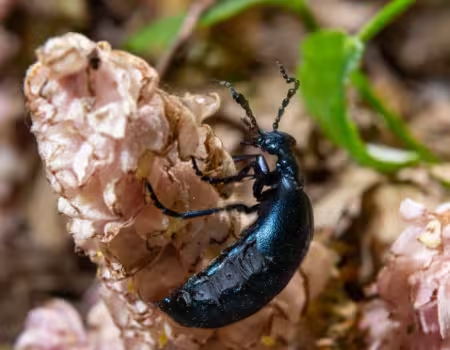
Like many strategies in the natural world, nest parasitism shows up in lots of different forms with different applications. Some species of nest parasites specialize in taking advantage of one type of host, while others might spread their efforts across different possible hosts. In some cases, nest parasites have little major impact on the hosts, while in others, their “donated” young can destroy or out-compete the hosts offspring. Finally, some nest parasites can reproduce only by getting someone else to care for their young. These are known as obligate parasites. By contrast, some other species are facultative, meaning that they can, but don’t necessarily have to use parasitism to reproduce.
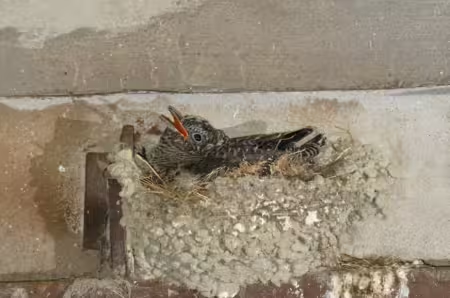
Females of some species will engage in what scientists call conspecific brood parasitism, where they lay eggs in the nests of other females of their species. Others will lay their eggs in the nests of different species. These heterospecific brood parasites may require special adaptations so that their babies can “blend in” and convince very different parents to care for them.
In call cases, the game has the same rules: nest parasites need to find a host who will care for their young, and potential hosts need to avoid being targets. These hosts are the “suckers” who invest time and energy in raising young that are not their own, and may lose their own offspring in the process.
What types of animals are brood or nest parasites?
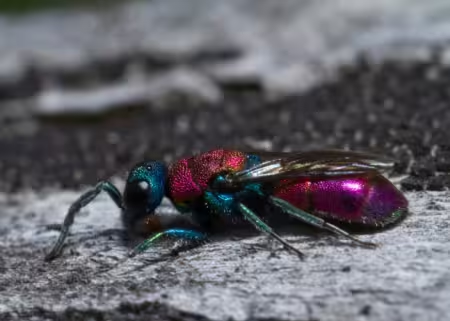
Any animals that must lay eggs or take care of them as part of their life cycle may have to deal with nest parasites. Learning about nearly every group of egg-laying animals, you can find examples of free-loaders taking advantage of someone else’s childcare effort. Some animals with widespread brood parasitism include:
- Fishes in the family Cyprinidae like shiners (Notropis sp.) and daces (Phoxinus), which are heterospecific brood parasites
- Five bird families, including the Icteridae or new-world blackbirds, ducks (Anatidae), and cuckoos (Cuculidae)
- Butterflies, especially in the blue family (Lycenidae)
- Bees, ants, and wasps (order Hymenoptera), famously the cuckoo-wasps (Chrysididae)
- Beetles (order Coleoptera) including the darkling beetles (family Tenebrionidae) and the dung beetles (family Scarabidae)
Trying to make sense of all these Latin names? Check out our Beginner’s guide to Taxonomy!
Which bird species display nest parasitism?
As the above examples suggest, brood and nest parasitism show up in the behavior of many birds. In fact, some of the best-studied examples of such freeloading occur in birds. Here are a few examples of avian brood parasites:
Eurasian cuckoos
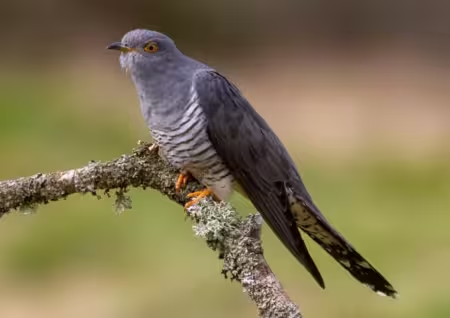
Perhaps the most infamous nest parasite is the Eurasian common cuckoo Cuculus canorus. An uncommon but widespread bird throughout temperate Europe and Asia, cuckoos are the focus of many fables, both for their sneaky way of raising young and their comical “cuck-oo!” song. This species of cuckoo is an extremely adept nest parasite, and is incapable of reproducing any other way. Amazingly, cuckoos in some areas lay eggs that closely match both the color and size of a given host species. This means that local groups of cuckoos are specialists at parasitizing certain hosts, often of several closely related species like warblers or flycatchers.
Read more: Why do people find birdsong relaxing?
If that weren’t impressive enough, cuckoo chicks also have some tricks of their sleeve. Similarly, the mouth shape and color, what ornithologists call the gape pattern, of cuckoo chicks can specifically match their host species. This makes it harder for the hosts to identify and reject these intruders. To top it off, cuckoo chicks are usually larger than their nest-mates, so their big mouths are a more attractive target for busy parents trying to feed their young. As a result, cuckoo chicks may get preferential treatment, letting their new siblings starve.
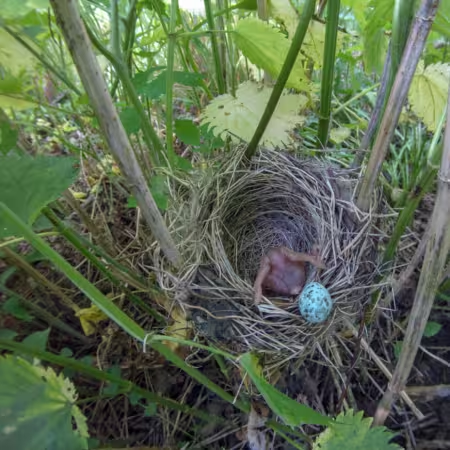
Finally, common cuckoo chicks have a sort of divot or depression in their back, which they can leverage like a dumptruck, backing up into their siblings as eggs or chicks and pushing them straight out of the nest! Once they’re shoved out onto the ground, the cuckoo’s adoptive siblings are doomed, and the cuckoo gets more attention from its new mom and dad.
Read more: What to do if you find a baby bird out of the nest
Do all cuckoos lay eggs in other birds’ nests?
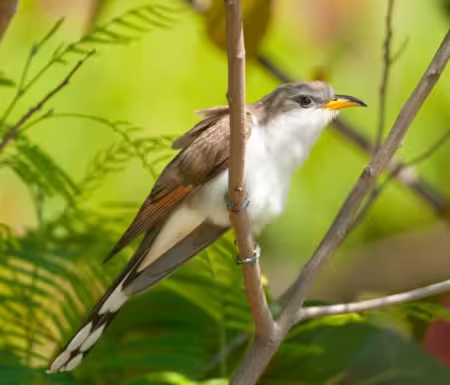
While many cuckoo species are nest parasites to a greater or lesser degree, the two most common North American cuckoos, the yellow-billed (Coccyzus americanus) and black-billed (Coccyzus erythropthalmus) cuckoos, are typically not. However, like many other things in nature, this has one major exception: when food is extremely abundant, yellow-billed cuckoos will occasionally parasitize the nests of black-billed cuckoos. This is especially common when periodical cicadas emerge in their giant numbers, presenting a feeding bonanza for the insect-eating cuckoos.
Read more: Periodical cicadas emerged in huge numbers in 2024
Brown-headed cowbird (Molothrus ater)
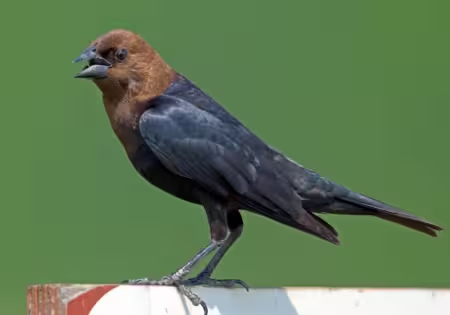
Where North American cuckoos are not “professional” nest parasites, the U.S., Canada, and Mexico are home to one prominent freeloader: the brown-headed cowbird. These pretty blackbirds can only reproduce by parasitizing the nests of other birds, and they do it plenty. Scientists have observed cowbirds plopping their eggs in the nests of unsuspecting warblers, sparrows, vireos, flycatchers, and other blackbirds. By some estimates, brown-headed cowbirds are probably an unwelcome guest in over 140 species of birds’ nests!
Diving ducks
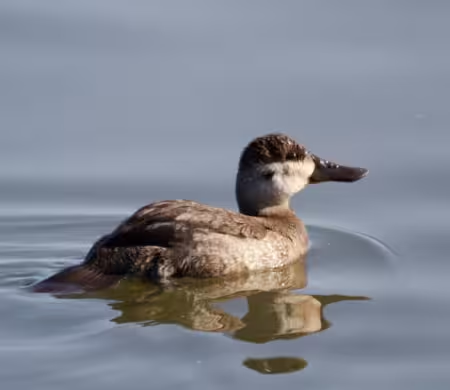
A surprisingly large number of diving ducks are nests parasites. One advantage that they have is that their ducklings are precocial, meaning that they are able to swim and feed themselves shortly after hatching. Because of this, freeloading duck mamas don’t have to worry about their babies being taken care of after they have been incubated by their unsuspecting adoptive mother.
What do baby crows look like? Precocial vs. altricial bird babies
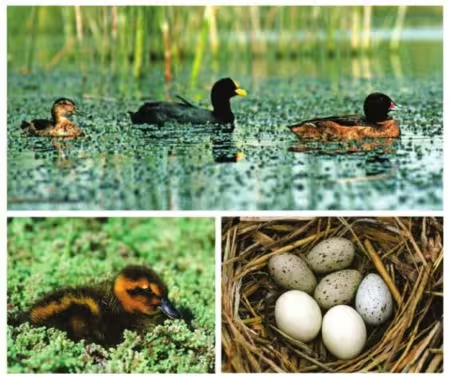
Most ducks that display nest parasitism are facultative nest parasites, so they nest on their own but may take advantage of opportunities to drop an egg in another nest if they find one. In other words, they can nest just fine on their own, and don’t have to nest parasitize the way that old world cuckoos and American cowbirds do. These extra eggs can be an “insurance policy” in case their own nest fails. Naturalists and ornithologists call this behavior egg dumping.
Parasitic duck species are also not particularly choosy about the nests that they lay in. They’re happy to drop an egg or two in a nest of their own species, but will also do so in the nests of surprisingly unrelated birds. For example, I once saw a young Ruddy duck (Oxyura jamaicensis) being carefully watched over by an American coot (Fulica americana), a very different type of bird! Ruddy ducks and their relatives are very frequent nest parasites; Redheads (Aythya americana) are as well, typically parasitizing goldeneyes (Bucephala sp.).
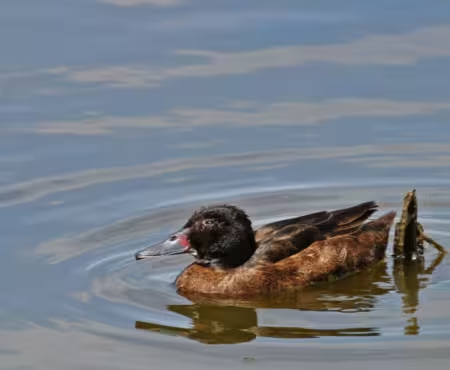
The black-headed duck
One South American duck, the black-headed duck (Heteronetta atricapilla) has especially impressive brood parasitism. Unlike their relatives, they are obligate nest parasites, and lay their eggs in a huge variety of nests. Scientists have observed them secreting eggs into the nests of coots, ibises, and several other duck species. Their ducklings tend to be even more independent, which allows them to get along fine with parents that are so different that they’d be less able to take care of them.
Sources and further reading
Tong, 2020. Understanding Bird Behavior. Princeton University Press
Spottiswoode, Claire N., Rebecca M. Kilner, and Nicholas B. Davies. “Brood parasitism.” The evolution of parental care (2012): 226-356.
Nestwatch, 2024. Brown-headed Cowbirds. Accessed September 2024.
Willson, M.F. 1984. Vertebrate Natural History. Saunders College Publishing HBJ, Fort Worth, TX.
Thanks for reading about nest parasitism!
If you enjoyed this post, please support the blog by sharing this post with friends. Follow Gulo in Nature on social media to get the latest from the blog. If you’ve got more nature related questions or content you’d like to see on the blog, get in touch using the Contact Page. We’d love to hear from you!

